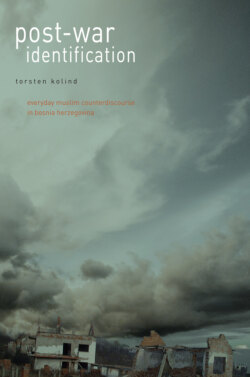Читать книгу Post-War Identification - Torsten Kolind - Страница 22
Relevance to my study
ОглавлениеI have outlined three different focuses of research in contemporary anthropology of war and war-related violence: instrumentality/structure, expression and experience/narratives. By focusing on processes of post-war identification (and its counterdiscursive aspect) among the Muslims of Stolac, I primarily adopt the last perspective. However, the other perspectives have also influenced my study.
In my historical account of the emergence of nationalism in Yugoslavia (Chapter 4) and more specifically in Bosnia Herzegovina (Chapter 9), I follow the instrumental perspective. While my aim is not to explain the war, I show how and why nationalist ideologies became so dominant. And one of the conclusions is that nationalist ideologies served to legitimise a rise to power. I use the structural argument only partly. In short, it is important to acknowledge that the war and war-related violence created a dichotomised space of identity. Ethnicity, which was only one identity among others before the war, came to the forefront throughout the war, increasingly determining everybody’s lives, and the actual violence and threats of violence contributed massively towards this change. The ethnic identity of some of the Muslims of Stolac became a matter of life or death; for most it was the reason they were expelled, and for the returnees it was the cause of their discrimination in post-war Stolac. The total destruction of everything reminiscent of the Ottoman influence (see Prologue) in Stolac also contributed in a violent way to create the ethnic Other. However, this is ‘only’ the framework; in my analysis I focus on how my informants fill up this framework in their everyday life, that is, how they relate to the ethnic identities promoted by the war. The focus on expression is only of indirect importance to my study. I primarily use it as an ethical reminder. First, violence can have an exotic entertainment value, as seen, for instance, in entertainment films. I have therefore been careful to restrict my presentation of examples to those necessary to present my argument. Second, I try to refrain from only depicting my informants as ‘victims of violence’ and thereby ‘othering’ them. Instead I analytically approach my informants’ use of the ‘role of the victim’ (Chapter 15). In Chapter 2, I follow the experience-oriented approach, demonstrating how the concept of ‘unmaking of the world’ is apt when generally describing my informants’ experiences of the war and post-war violence. The focus on the unmaking of the world is important for two reasons. First, inspired by the epistemological discussion ascribed to this research approach, the validity of my own as well as my informants’ representations can be questioned. If it is true that the unmaking of the world also implies destroying the categories normally used to communicate experience, then both my analysis and my informants’ accounts are somewhat blurred. This does not make my analysis of my informants’ post-war identifications irrelevant or invalid, but it has helped me to persistently focus on the very act of category building. My representation of Muslims’ ways of identifying themselves and the Other therefore goes into detail with this process of reconstructing categories and looks into how they eventually build upon pre-war classifications. Second, my book is based on the analytical division of unmaking – remaking, with emphasis on the latter. By looking into the unmade world of my informants it becomes clear how profound the devastations of the war have been, and consequently how profoundly my informants have had to question, reconsider and remake their social relations, friendships, religious beliefs, moral values, conception of the nature of society, ethnic identities and so on. Cultural construction takes place everywhere, all the time; in Stolac, however, such cultural construction is so profound and extensive that it is apposite to term it remaking. And it is this process of remaking with emphasis on the question of identification that is my major focus. The theoretical background for my analysis of this process of remaking and identification, and especially for considering this as a counterdiscursive practice, is presented in Chapter 3.
1 Although, as argued by Sluka (2000), state violence should not (only) be seen as an instrument with which potential elites can seize power in periods of eroding state power. Rather, state violence tends to increase when the power of the state increases, as strong states do not have to take into consideration their ways of defending established inequalities, and violence is often the most economical means of protecting privileges. Therefore, according to Sluka, it is not disintegration of the Weberian state that explains contemporary excesses in state-related violence (as argued, for instance, by Desjarlais 1994; Brubaker 1998), but rather the opposite.
2 The argument is that violent conflicts are outbursts of latent ethnic, religious, cultural or other essential differences.
3 Analyses on such analytical levels are often rather speculative. One could argue otherwise and claim that violence itself has become a disembedded practice. As Bauman’s (1994) study of the Holocaust shows, violence in modern bureaucratic systems has in fact been lifted out of concrete social relations and developed into a rational bureaucratic tool. Violence thus becomes devoid of meaning and purely instrumental –an instrument not of an actor, but of a bureaucratic system. In a similar vein, Pick (1993) argues that the acts of violence and slaughtering (both of animals and men) in Western Europe in the past 150 years have followed the overall pattern of systematic industrial rationality.
4 Studies of the experience of perpetrators of violence are very rare (Schmidt and Schröder 2001).
5 A point raised by Ivana Maček (personal correspondence).
6 By the term narrative I mean clusters of speech and action that are moral and cosmological and which have an internal structure that organises the past and gives directions for the future; these clusters draw on external sources (discourses) for their constructions (see Mattingly 2001).
